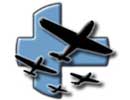| |
In the early years several different military aircraft marking systems were used in Finland. The first aircraft of the Aviation Forces were given inventory numbers F.1 to F.40 (F = Flygmaskin), but these were never applied on aircraft. After F.5 only even numbers were used.
- The first official system was introduced on 20 June 1918, the marking was for example like C.56/18, where:
- The first letter (C) shows the purpose of the aircraft
- A = monoplane, unarmed
- B = biplane, unarmed
- C = biplane, armed
- D = biplane, single seated, armed
- E = monoplane, armed
- M = biplane, fixed machine gun
- S = trainer
- The letter is followed by a serial number (56) and the last two digits (18) give the year the aircraft was taken in use. The serial number was greater than 50 and the last serial number given in this system was 91.
- D.63/18 was a Nieuport 10 (!)
- C.72-18 was a Friedrichshafen FF 49c
- The marking was to be applied with black, 20 cm high lettering on both sides of the tail.
- From 20 August 1919 on the 2C.460 type marking was in use, where:
- The first number (2) is the number of seats.
- The letter (C) is the basic function of the aircraft
- A = trainer
- B = reconnaissance aircraft
- C = combat aircraft, biplane
- D = combat aircraft, monoplane
- E = twin engined aircraft
- The first number after the letter (4) is the country of origin
- 1 = Russian
- 2 = Swedish
- 3 = German
- 4 = French
- 5 = Italian
- The last two digits (60) form the serial number, which for landplanes was greater than 50.
- 2C.460 (also 2C460) was a Bréguet 14 A2
- 2B.477. was also a Bréguet 14 A2
- 1.D.453. was a Nieuport 16
- 2C 302. was a Friedrichshafen FF 49c
- In the beginning of the year 1922 a shorter marking was taken in use, for example 3C.30., which is formed as follows:
- The first number (3) is the basic function of the aircraft
- 1 = basic trainer
- 2 = advanced trainer
- 3 = reconnaissance aircraft
- 4 = maritime reconnaissance aircraft
- 5 = (maritime fighter or trainer?)
- 6 = (maritime torpedo bomber?)
- 8 = fighter
- The letter (C) is a code for the year when built/acquired
- A = 1919
- B = 1920
- C = 1921
- D = 1922
- E = 1923
- F = 1924
- G = 1925
- H = 1926
- The letter is followed by a serial number.
- 3C.30. (also 3C30. used later) was a Bréguet 14 A2 acquired in 1921
- 4.F.47 was an I.V.L. A.22 Hansa built in 1924
There was a lot of variation in the way points were used in the two above mentioned systems.
Finaly on 1 June 1927 a new system, which consists of a type code and a serial number and which is still in use today, was introduced. For example MA-24, where MA is a code for Martinsyde F.4 Buzzard. Initially each group of aircraft (fighters, bombers, maritime reconnaissance aircraft, reconnaissance aircraft, advanced trainers, basic trainers) received consecutive serial numbers, MA-24 was thus the 24th fighter to be given this type of registration.
The consecutiveness of the serial numbers was partly abandoned during WW2, as the number of aircraft mushroomed and batches of aircraft were given serial numbers that started from 201, 251, 301 etc., with blanks and overlaps. More recent jets seem to follow similar pattern. Another way was to start a fresh set of serial numbers from 1, this was often used for training aircraft and more generally during and after the war.
| |
